State of the Art of Geodiversity, Geoconservation, and Geotourism in Costa Rica
Abstract
1. Introduction
2. Materials and Methods
2.1. Geographical Setting of Costa Rica
2.2. Geodiversity and Geotourism in Costa Rica
2.3. Environmental Policies and Geoheritage in Costa Rica
3. Results
3.1. Geomorphic Environments and Geodiversity of Costa Rica
3.2. Geoheritage and Environmental Policies in Costa Rica
4. Discussion
5. Conclusions
Author Contributions
Funding
Acknowledgments
Conflicts of Interest
References
- Wang, L.; Tian, M.; Wang, L. Geodiversity, geoconservation and geotourism in Hong Kong global geopark of China. Proc. Geol. Assoc. 2015, 126, 426–437. [Google Scholar] [CrossRef]
- Gray, M. Geodiversity: Valuing and Conserving Abiotic Nature, 2nd ed.; Wiley: Hoboken, NJ, USA, 2013; pp. 3–14. [Google Scholar]
- Zwoliński, Z. Geodiversity. In Encyclopedia of Geomorphology; Goudie, A.S., Ed.; Routledge: London, UK, 2004; Volume 1, pp. 417–418. [Google Scholar]
- Benito, A.; Pérez, A.; Magri, O.; Meza, P. Assessing regional geodiversity: The Iberian Peninsula. Earth Surf. Proc. Land. 2009, 34, 1433–1445. [Google Scholar] [CrossRef]
- Castree, N. Earth System Science. In The International Encyclopedia of Geography; Brunn, S.D., Ed.; Wiley: Hoboken, NJ, USA, 2019. [Google Scholar] [CrossRef]
- Dóniz-Páez, J.; Becerra-Ramírez, R.; Serrano Patón, M.; Báez-Hernández, M. Geodiversidad, Geopatrimonio y Geoturismo en los espacios naturales protegidos del Geoparque volcánico de El Hierro (Canarias, España). In Proceedings of the XXIII Coloquio de Historia Canario-Americana, Las Palmas, Spain, 8–12 October 2018. [Google Scholar]
- Serrano, E.; Ruiz-Flaño, P. Geodiversity: A theoretical and applied concept. Geogr. Helv. 2007, 62, 140–147. [Google Scholar] [CrossRef]
- Reynard, E.; Brilha, J. Geoheritage: A multidisciplinary and applied research topic. In Geoheritage; Reynard, E., Brilha, J., Eds.; Elsevier: Amsterdam, The Netherlands, 2018; pp. 3–9. [Google Scholar]
- Gordon, J.E. Geoconservation principles and protected area management. Int. J. Geoherit. Parks 2019, 7, 199–210. [Google Scholar] [CrossRef]
- Newsome, D.; Dowling, R. Geoheritage and geotourism. In Geoheritage; Reynard, E., Brilha, J., Eds.; Elsevier: Amsterdam, The Netherlands, 2018; pp. 305–321. [Google Scholar]
- Gordon, J.E.; Crofts, R.; Díaz-Martínez, E.; Woo, K. Enhancing the role of geoconservation in protected area management and nature conservation. Geoheritage 2018, 10, 191–203. [Google Scholar] [CrossRef]
- Zwoliński, Z.; Najwer, A.; Giardino, M. Methods for assessing geodiversity. In Geoheritage; Reynard, E., Brilha, J., Eds.; Elsevier: Amsterdam, The Netherlands, 2018; pp. 27–52. [Google Scholar]
- Mucivuna, V.; Reynard, E.; Garcia, M. Geomorphosites assessment methods: Comparative analysis and typology. Geoheritage 2019, 11, 1799–1815. [Google Scholar] [CrossRef]
- Migoń, P. Geoheritage and World Heritage Sites. In Geoheritage; Reynard, E., Brilha, J., Eds.; Elsevier: Amsterdam, The Netherlands, 2018; pp. 237–249. [Google Scholar]
- Brilha, J. Geoheritage and geoparks. In Geoheritage; Reynard, E., Brilha, J., Eds.; Elsevier: Amsterdam, The Netherlands, 2018; pp. 323–335. [Google Scholar]
- Pérez-Umaña, D. Evaluación del Potencial Turístico de Geomorfositios del Parque Nacional Volcán Poás. Bachelor’s Thesis, Universidad Nacional de Costa Rica, Heredia, Costa Rica, 2017. [Google Scholar]
- Pérez-Umaña, D.; Quesada-Román, A. Metodología para la valoración y evaluación de geomorfositios en Costa Rica. Rev. Geogr. Am. Cent. 2018, 60, 117–135. [Google Scholar] [CrossRef]
- Pérez-Umaña, D.; Quesada-Román, A.; De Jesús-Rojas, J.; Zamorano-Orozco, J.; Dóniz-Páez, J.; Becerra-Ramírez, R. Comparative analysis of geomorphosites in volcanoes of Costa Rica, Mexico, and Spain. Geoheritage 2019, 11, 545–559. [Google Scholar] [CrossRef]
- Pérez-Umaña, D.; Quesada-Román, A.; Tefogoum, G. Geomorphological heritage inventory of Irazú Volcano, Costa Rica. Int. J. Geoheritige Parks 2020, 8, 31–47. [Google Scholar] [CrossRef]
- Quesada-Román, A.; Pérez-Umaña, D. Tropical paleoglacial geoheritage inventory for geotourism management of Chirripó National Park, Costa Rica. Geoheritage 2020, in press. [Google Scholar]
- Dowling, R.; Newsome, D. Geotourism: Definition, characteristics and international perspectives. In Handbook of Geotourism; Dowling, R., Newsome, D., Eds.; Edward Elgar: Cheltenham, UK, 2018; pp. 1–22. [Google Scholar]
- Pralong, J.P. A method for assessing tourist potential and use of geomorphological sites. Géomorphologie 2005, 1, 189–196. [Google Scholar] [CrossRef]
- Kubalíková, L. Assessing geotourism resources on a local level: A case study from Southern Moravia (Czech Republic). Resources 2019, 8, 150. [Google Scholar] [CrossRef]
- Dowling, R.; Newsome, D. (Eds.) Geotourism; Elsevier/Heineman Pub.: Oxford, UK, 2006. [Google Scholar]
- Newsome, D.; Dowling, R. (Eds.) Geotourism: The Tourism of Geology and Landscape; Goodfellow Publishers Ltd.: Oxford, UK, 2010. [Google Scholar]
- Dowling, R.; Newsome, D. (Eds.) Global Geotourism Perspectives; Goodfellow Publishers Ltd.: Oxford, UK, 2010. [Google Scholar]
- Dowling, R.; Newsome, D. (Eds.) Handbook of Geotourism; Edward Elgar Pub.: Cheltenham, UK, 2018. [Google Scholar]
- Newsome, D.; Dowling, R.; Leung, Y.F. The nature and management of geotourism: A case study of two established iconic geotourism destinations. Tour. Manag. Perspect. 2012, 2–3, 19–27. [Google Scholar] [CrossRef]
- Jones, G.; Spadafora, A. Creating Ecotourism in Costa Rica, 1970–2000. Enterp. Soc. 2017, 18, 146–183. [Google Scholar] [CrossRef]
- Nanni, A.; Sloan, S.; Aide, T.; Graesser, J.; Edwards, D.; Grau, H. The neotropical reforestation hotspots: A biophysical and socioeconomic typology of contemporary forest expansion. Glob. Environ. Chang. 2019, 54, 148–159. [Google Scholar] [CrossRef]
- Valverde-Sanchez, R. Conservation strategies, protected areas, and ecotourism in Costa Rica. J. Park Recreat. Adm. 2018, 36, 115–128. [Google Scholar] [CrossRef]
- World Travel & Tourism Council. Annual Research: Key Highlights by Country; World Travel & Tourism Council: London, UK, 2019. [Google Scholar]
- ICT—Costa Rican Tourism Board. National Tourism Data. 2019. Available online: http://www.ict.go.cr/es/estadisticas.html (accessed on 20 February 2020).
- Catana, M.; Brilha, J. The Role of UNESCO global geoparks in promoting geosciences education for sustainability. Geoheritage 2020, 12. [Google Scholar] [CrossRef]
- Pérez-Umaña, D.; Quesada-Román, A. Una Propuesta para la Valoración de Geoparques en Costa Rica. Anuá. Inst. Geociê. 2018, 41, 382–394. [Google Scholar] [CrossRef]
- Alvarado, G.; Benito, B.; Staller, A.; Climent, A.; Camacho, E.; Rojas, W.; Marroquín, G.; Molina, E.; Talavera, J.E.; Martínez-Cuevas, S.; et al. The new Central American seismic hazard zonation: Mutual consensus based on up to day seismotectonic framework. Tectonophysics 2017, 721, 462–476. [Google Scholar] [CrossRef]
- Marshall, J. The geomorphology and physiographic provinces of Central America. In Central America: Geology, Resources and Hazards; Bundschuc, J., Alvarado, G., Eds.; Taylor & Francis: London, UK, 2007. [Google Scholar]
- Denyer, P.; Alvarado, G. Mapa Geológico de Costa Rica; Escala 1:400 000; Librería Francesa: San José, Costa Rica, 2007. [Google Scholar]
- Alvarado, G. Los Volcanes de Costa Rica: Geología, Historia, Riqueza Natural y su Gente; EUNED: San José, Costa Rica, 2011. [Google Scholar]
- Quesada-Román, A.; Pérez-Briceño, P. Geomorphology of the Caribbean coast of Costa Rica. J. Maps 2019, 15, 363–371. [Google Scholar] [CrossRef]
- Amador, J.A.; Alfaro, E.J.; Rivera, E.R.; Calderón, B. Climatic features and their relationship with tropical cyclones over the Intra-Americas seas. In Hurricanes and Climate Change; Elsner, J.B., Jagger, T.H., Eds.; Springer: Dordrecht, The Netherlands, 2010; pp. 149–173. [Google Scholar]
- Maldonado, T.; Alfaro, E.; Hidalgo, H. A review of the main drivers and variability of Central America’s Climate and seasonal forecast systems. Rev. Biol. Trop. 2018, 66, S153–S175. [Google Scholar] [CrossRef]
- Kappelle, M. Costa Rican Ecosystems; University of Chicago Press: Chicago, IL, USA, 2018. [Google Scholar]
- Keenan, R.J.; Reams, G.A.; Achard, F.; de Freitas, J.V.; Grainger, A.; Lindquist, E. Dynamics of global forest area: Results from the FAO Global Forest Resources Assessment 2015. For. Ecol. Manag. 2015, 352, 9–20. [Google Scholar] [CrossRef]
- Van Lidth de Jeude, M.; Schütte, O.; Quesada, F. The vicious circle of social segregation and spatial fragmentation in Costa Rica’s greater metropolitan area. Habitat Int. 2016, 54, 65–73. [Google Scholar] [CrossRef]
- Méndez, M.; Calvo-Valverde, L.; Maathuis, B.; Alvarado-Gamboa, L.F. Generation of monthly precipitation climatologies for costa rica using irregular rain-gauge observational networks. Water 2019, 11, 70. [Google Scholar] [CrossRef]
- Molina-Murillo, S.A. Certificación turística sostenible y los impactos socioeconómicos percibidos por hoteles en Costa Rica. PASOS 2019, 17, 363–372. [Google Scholar] [CrossRef]
- Hunt, C.; Harbor, L. Pro-environmental tourism: Lessons from adventure, wellness and eco-tourism (AWE) in Costa Rica. J. Outdoor Recreat. Tour. 2019, 28. [Google Scholar] [CrossRef]
- Bergoeing, J. Geomorphology and Volcanology of Costa Rica; Elsevier: Amsterdam, The Netherlands, 2017; p. 280. [Google Scholar]
- Cortés, J. Coastal morphology and coral reefs. In Central America: Geology, Resources and Hazards; Bundschuc, J., Alvarado, G., Eds.; Taylor & Francis: London, UK, 2007. [Google Scholar]
- Day, M. Karst landscapes. In Central America: Geology, Resources and Hazards; Bundschuc, J., Alvarado, G., Eds.; Taylor & Francis: London, UK, 2007. [Google Scholar]
- Ulloa, A.; Aguilar, T.; Goicoechea, C.; Ramírez, R. Descripción, clasificación y aspectos geológicos de las zonas kársticas de Costa Rica. Rev. Geol. Am. Cent. 2011, 45, 53–74. [Google Scholar] [CrossRef]
- Lachniet, M.; Seltzer, G. Late Quaternary glaciation of Costa Rica. Geol. Soc. Am. Bull. 2002, 114, 547–558. [Google Scholar] [CrossRef]
- Quesada-Román, A.; Stoffel, M.; Ballesteros-Cánovas, J.; Zamorano-Orozco, J. Glacial geomorphology of the Chirripó National Park, Costa Rica. J. Maps 2019, 15, 538–545. [Google Scholar] [CrossRef]
- Smith, M.; Paron, P.; Griffiths, J. Geomorphological Mapping: Methods and Applications; Elsevier: Amsterdam, The Netherlands, 2011. [Google Scholar]
- López-Angarita, J.; Roberts, C.M.; Tilley, A.; Hawkins, J.P.; Cooke, R.G. Mangroves and people: Lessons from a history of use and abuse in four Latin American countries. For. Ecol. Manag. 2016, 368, 151–162. [Google Scholar] [CrossRef]
- Ministerio de Agricultura y Ganadería. Compilación de Leyes y Decretos Ejecutivos Sobre Parques Nacionales y Reservas Biológicas; Imprenta Nacional: San José, Costa Rica, 1978.
- García, R. Biología de la Conservación: Conceptos y Prácticas; Editorial INBio: Santo Domingo de Heredia, Costa Rica, 2002. [Google Scholar]
- Gámez, R.; Obando, V. La Biodiversidad. In Costa Rica en el Siglo XX; Rodríguez, E., Ed.; EUNED: San José, Costa Rica, 2005; pp. 138–191. [Google Scholar]
- Sastre, M. Patrimonio natural geológico y su accesibilidad a su disfrute. Teach. Earth Sci. 2007, 16, 2–8. [Google Scholar]
- Meza, T. Geografía de Costa Rica: Geología, Naturaleza y Políticas Ambientales; Editorial Tecnológica de Costa Rica: Cartago, Costa Rica, 2001. [Google Scholar]
- Vargas, G. Geografía de Costa Rica; EUNED: San José, Costa Rica, 2014. [Google Scholar]
- Investigaciones Jurídicas. Constitución Política de la República de Costa Rica; Editorial Investigaciones Jurídicas S.A.: San José, Costa Rica, 2013. [Google Scholar]
- SINALEVI. Ley Sobre Patrimonio Nacional Arqueológico; 1982. Available online: http://www.pgrweb.go.cr/ (accessed on 22 October 2019).
- SINALEVI. Ley Orgánica del Instituto Costarricense de Turismo; 2010. Available online: http://www.pgrweb.go.cr/ (accessed on 20 September 2019).
- SINALEVI. Ley Forestal (1969); 2012. Available online: http://www.pgrweb.go.cr/ (accessed on 19 August 2019).
- SINALEVI. Ley de Biodiversidad; 2019. Available online: http://www.pgrweb.go.cr/ (accessed on 22 October 2019).
- Zeledón, R. Código Ambiental; Porvenir: San José, Costa Rica, 1999. [Google Scholar]
- Coratza, P.; Ghinoi, A.; Piacentini, D.; Valdati, J. Management of geomorphosites in high tourist vocation área: An example of geo-hiking maps in the Alpe Di Fanes (Natural Park of Fanes-Senes-Braies, Italian Dolomites). GeoJ. Tour. Geosites 2008, 2, 106–117. [Google Scholar]
- Palacio, J. Geositios, geomorfositios y geoparques: Importancia, situación actual y perspectivas en México. Inv. Geogr. 2013, 82, 24–37. [Google Scholar] [CrossRef]
- De Jesús, J.C. Geomorfositios en el volcán Paricutín, Michoacán, México. Bachelor’s Thesis, Universidad Nacional Autónoma de México, Mexico City, Mexico, 2014. [Google Scholar]
- Pérez-Umaña, D. Geodiversidad y geopatrimonio en las áreas silvestres de Costa Rica. Ambientico 2019, 271, 59–65. [Google Scholar]
- UNESCO. Evaluación Ambiental Estratégica en sitios Patrimonio Mundial naturales. 2017. Available online: http://www.unesco.org/new/es/media-services/single-view-tv-release/news/strategic_environmental_assessment_in_natural_world_heritage/ (accessed on 22 October 2019).
- Earth Charter. Principle III: Social and Economic Justice. Earth Charter International. 2020. Available online: https://earthcharter.org/read-the-earth-charter/social-and-economic-justice/ (accessed on 22 October 2019).
- Reynard, E.; Bussard, J.; Grangier, L.; Martin, S. Integrated approach for the inventory and management of geomorphological heritage at the regional scale. Geoheritage 2016, 8, 43–60. [Google Scholar] [CrossRef]
- Acuña-Piedra, J.F.; Quesada-Román, A. Evolución geomorfológica entre 1948 y 2012 del delta Térraba–Sierpe, Costa Rica. Cuat. Geomorf. 2016, 30, 49–73. [Google Scholar] [CrossRef]
- Quesada-Román, A.; Mata-Cambronero, E. The geomorphic landscape of the Barva Volcano, Costa Rica. Phys. Geogr. 2020. [Google Scholar] [CrossRef]
- Bundschuc, J.; Birkle, P.; Finch, R.C.; Day, M.; Romero, J.; Paniagua, S.; Alvarado, G.E.; Bhattacharya, P.; Tippman, K.; Chaves, D. Geology-related tourism for sustainable development. In Central America: Geology, Resources and Hazards; Bundschuc, J., Alvarado, G., Eds.; Taylor & Francis: London, UK, 2007. [Google Scholar]
- Quesada-Román, A. Cartografía geomorfológica de la cuenca del río Guacimal, Costa Rica. Rev. Geogr. Ven. 2018, 59, 12–27. Available online: http://www.saber.ula.ve/handle/123456789/44691 (accessed on 31 October 2019).
- Quesada-Román, A.; Campos, N.; Alcalá-Reygosa, J.; Granados-Bolaños, S. Equilibrium-line altitude and temperature reconstructions during the Last Glacial Maximum in Chirripó National Park, Costa Rica. J. S. Am. Earth Sci. 2020, 100, 102576. [Google Scholar] [CrossRef]
- Veas-Ayala, N.; Quesada-Román, A.; Hidalgo, H.; Alfaro, E. Humedales del Parque Nacional Chirripó, Costa Rica: Características, relaciones geomorfológicas y escenarios de cambio climático. Rev. Biol. Trop. 2018, 66, 1436–1448. [Google Scholar] [CrossRef]
- Benado, J.; Hervé, F.; Schilling, M.; Brilha, J. Geoconservation in Chile: State of the art and analysis. Geoheritage 2019, 11, 793–807. [Google Scholar] [CrossRef]
- Carcavilla, L.; Durán, J.; García-Cortés, Á.; López-Martínez, J. Geological heritage and geoconservation in Spain: Past, present, and future. Geoheritage 2009, 1, 75–91. [Google Scholar] [CrossRef]
- De Wever, P.; Alterio, I.; Egoroff, G.; Cornée, A.; Bobrowsky, P.; Collin, G.; Duranthon, F.; Hill, W.; Lalanne, A.; Page, K. Geoheritage, a national inventory in France. Geoheritage 2015, 7, 205–247. [Google Scholar] [CrossRef]
- Newsome, D.; Johnson, C.P. Potential geotourism and the prospect of raising awareness about geoheritage and environment on Mauritius. Geoheritage 2013, 5, 1–9. [Google Scholar] [CrossRef]
- Sánchez-Cortez, J. Conservation of geoheritage in Ecuador: Situation and perspectives. Int. J. Geoherit. Parks 2019, 7, 91–101. [Google Scholar] [CrossRef]
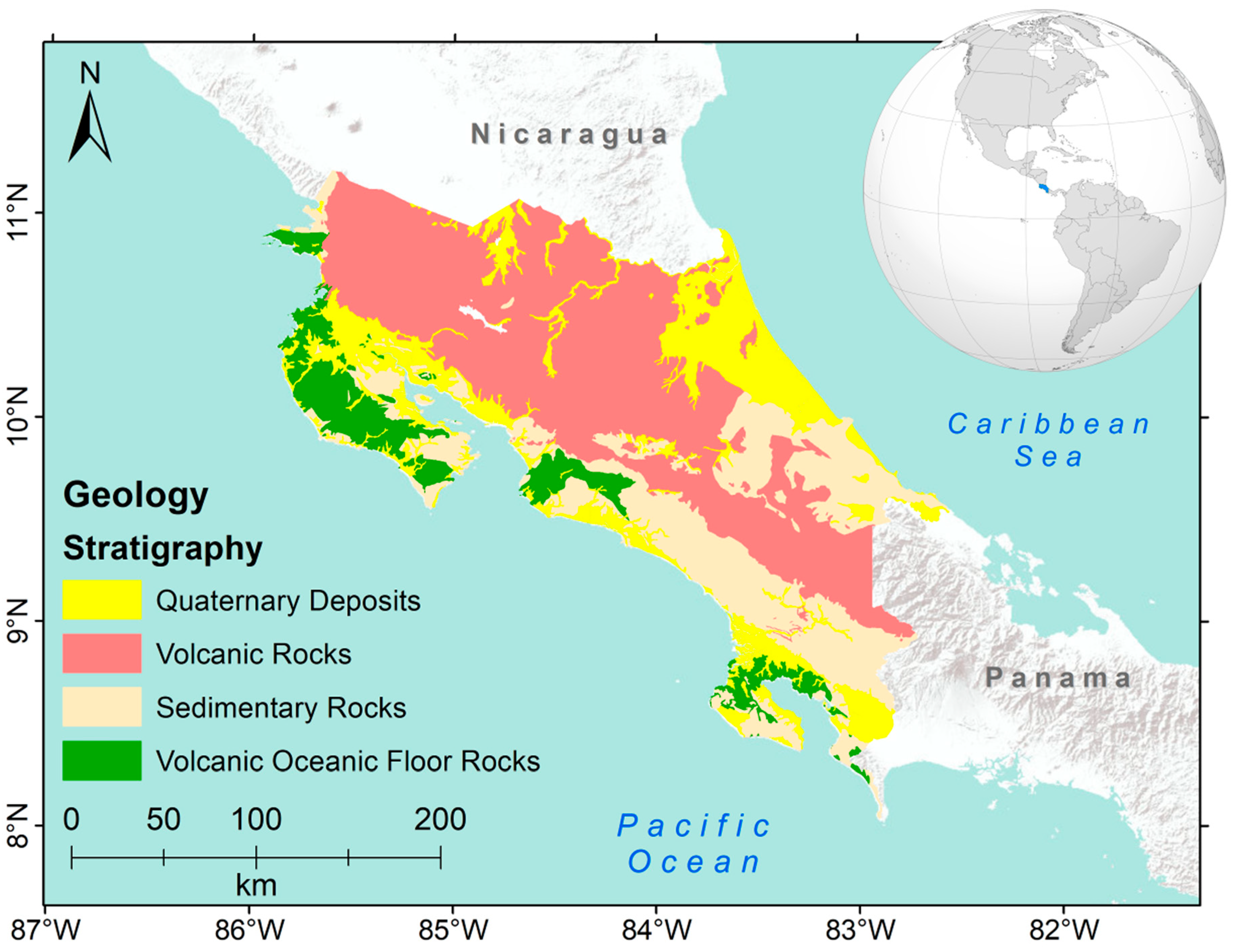
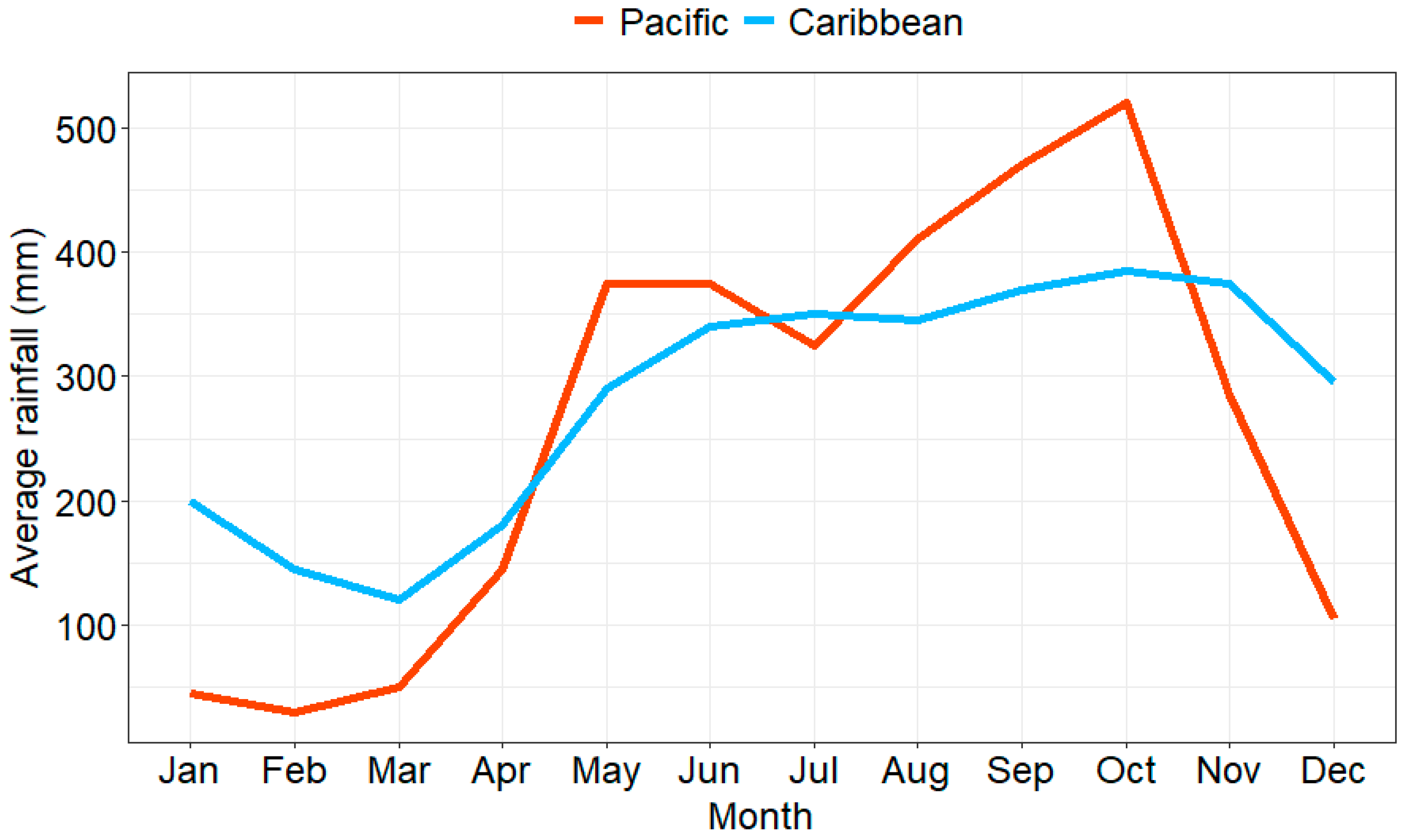


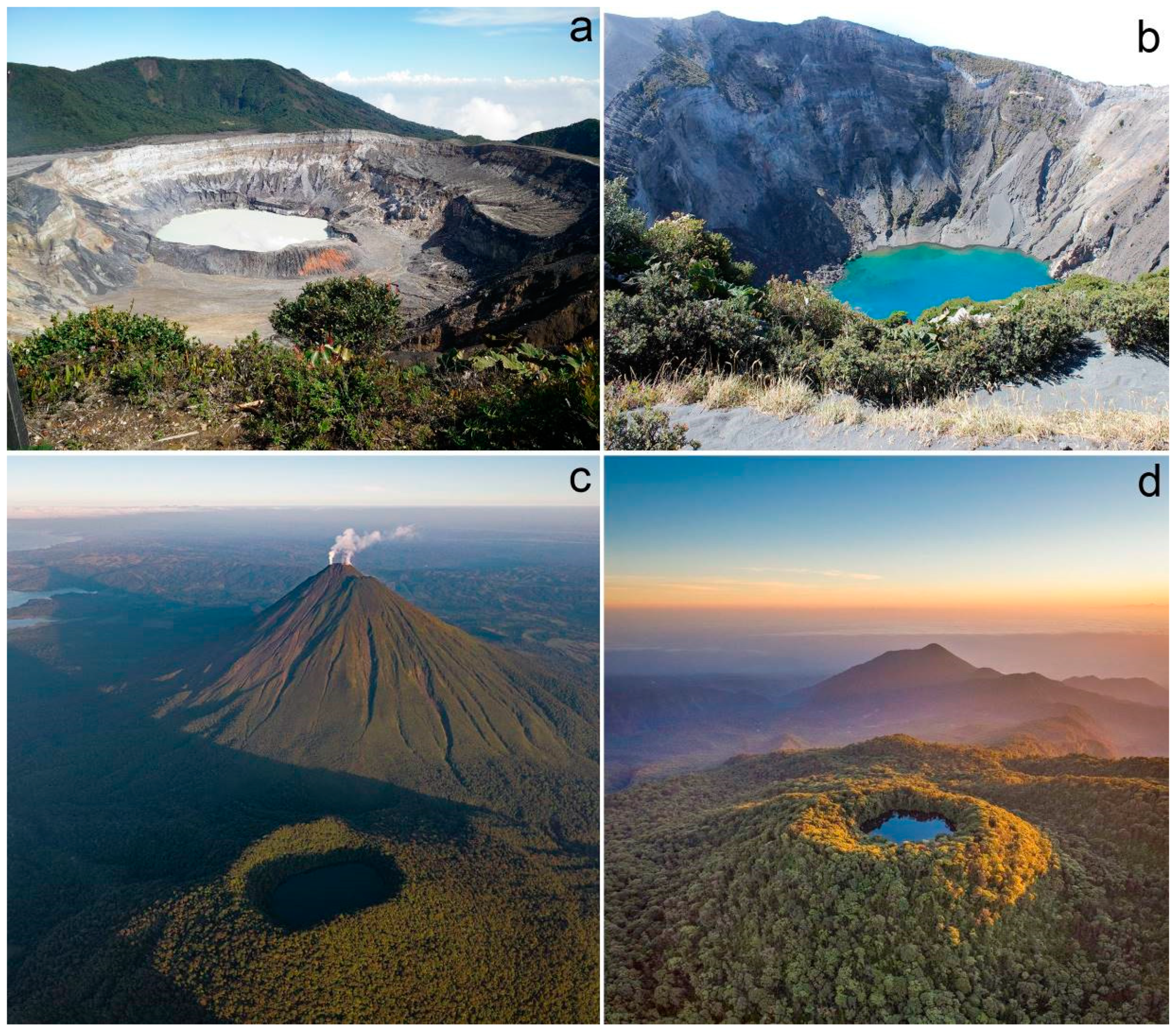
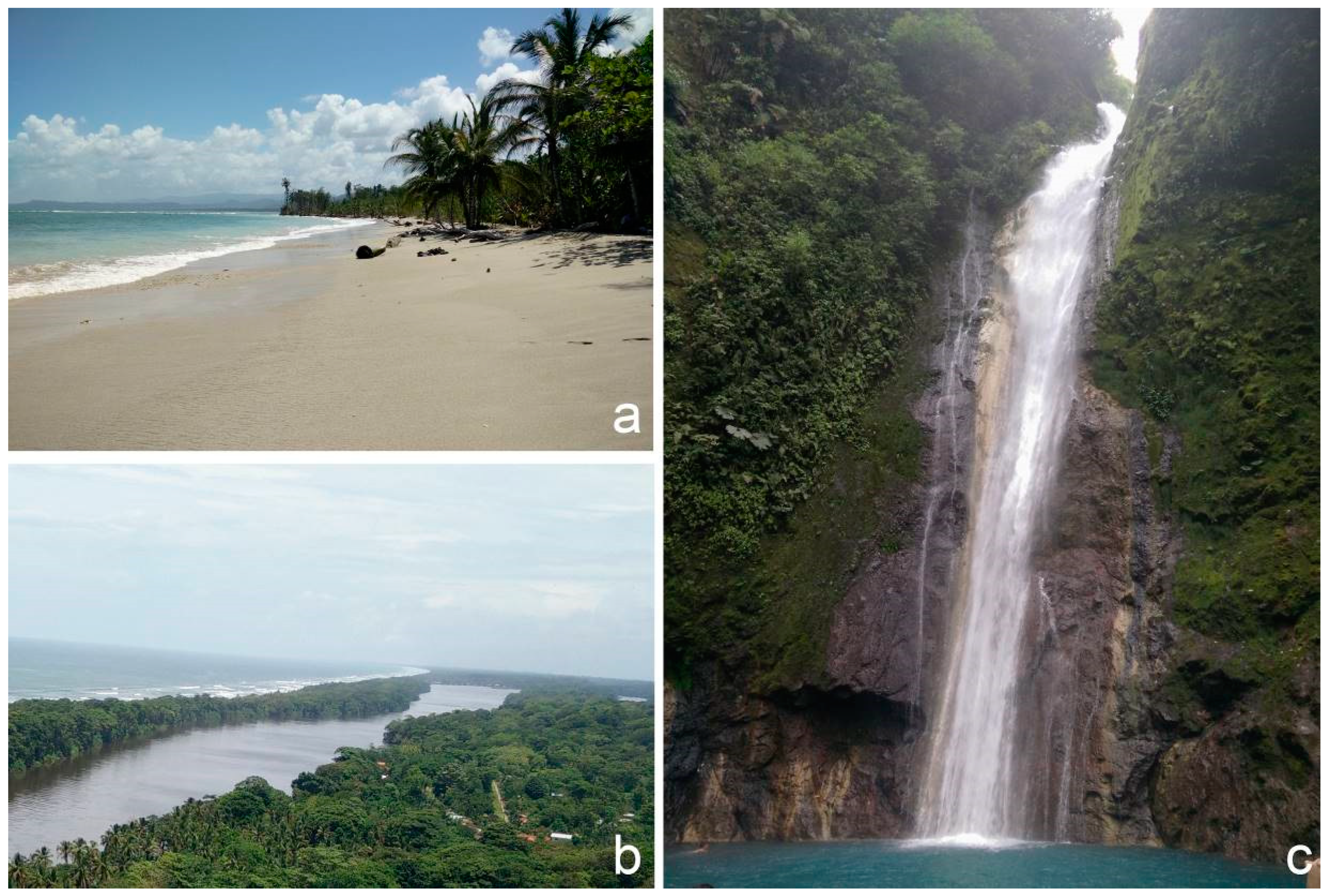

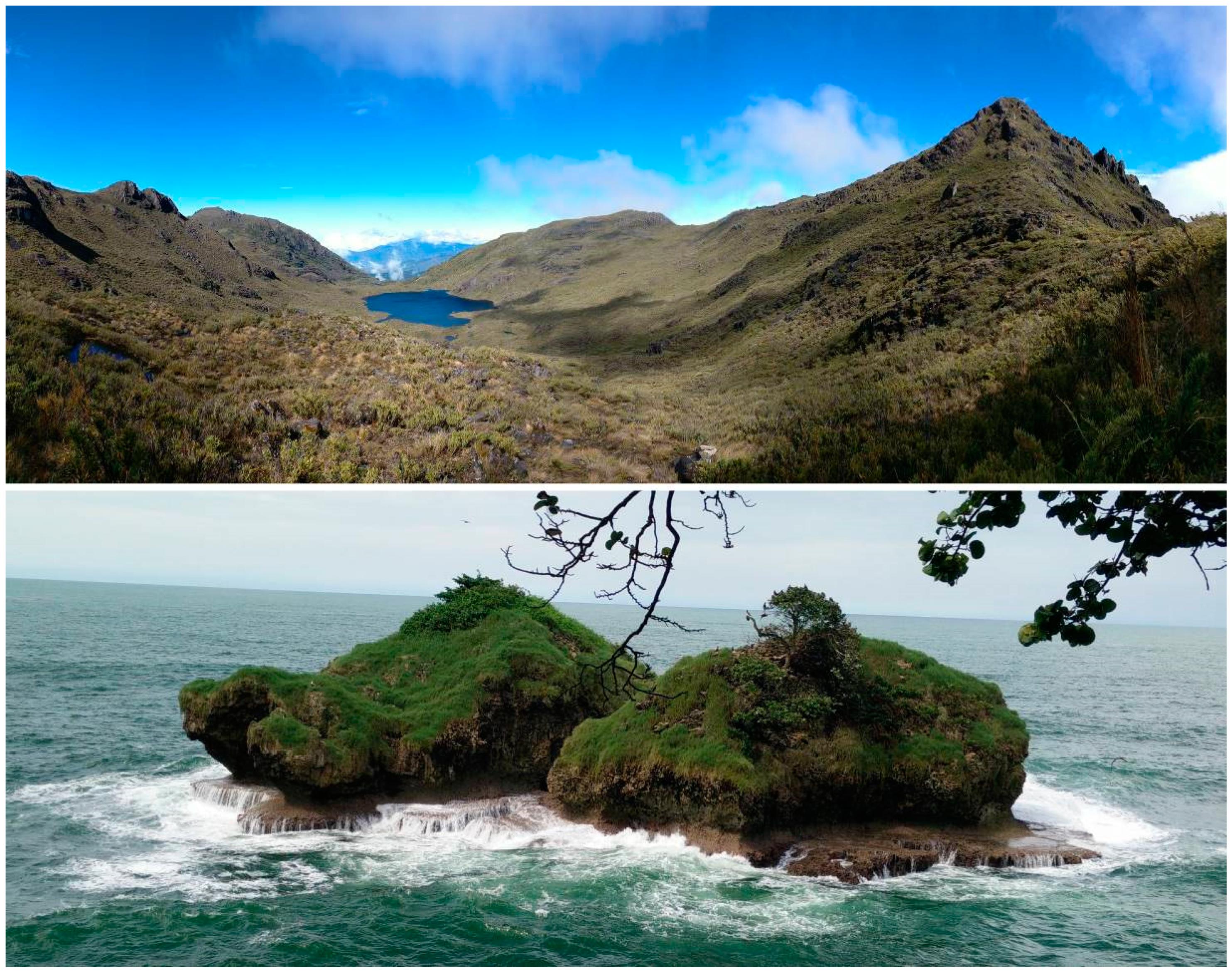
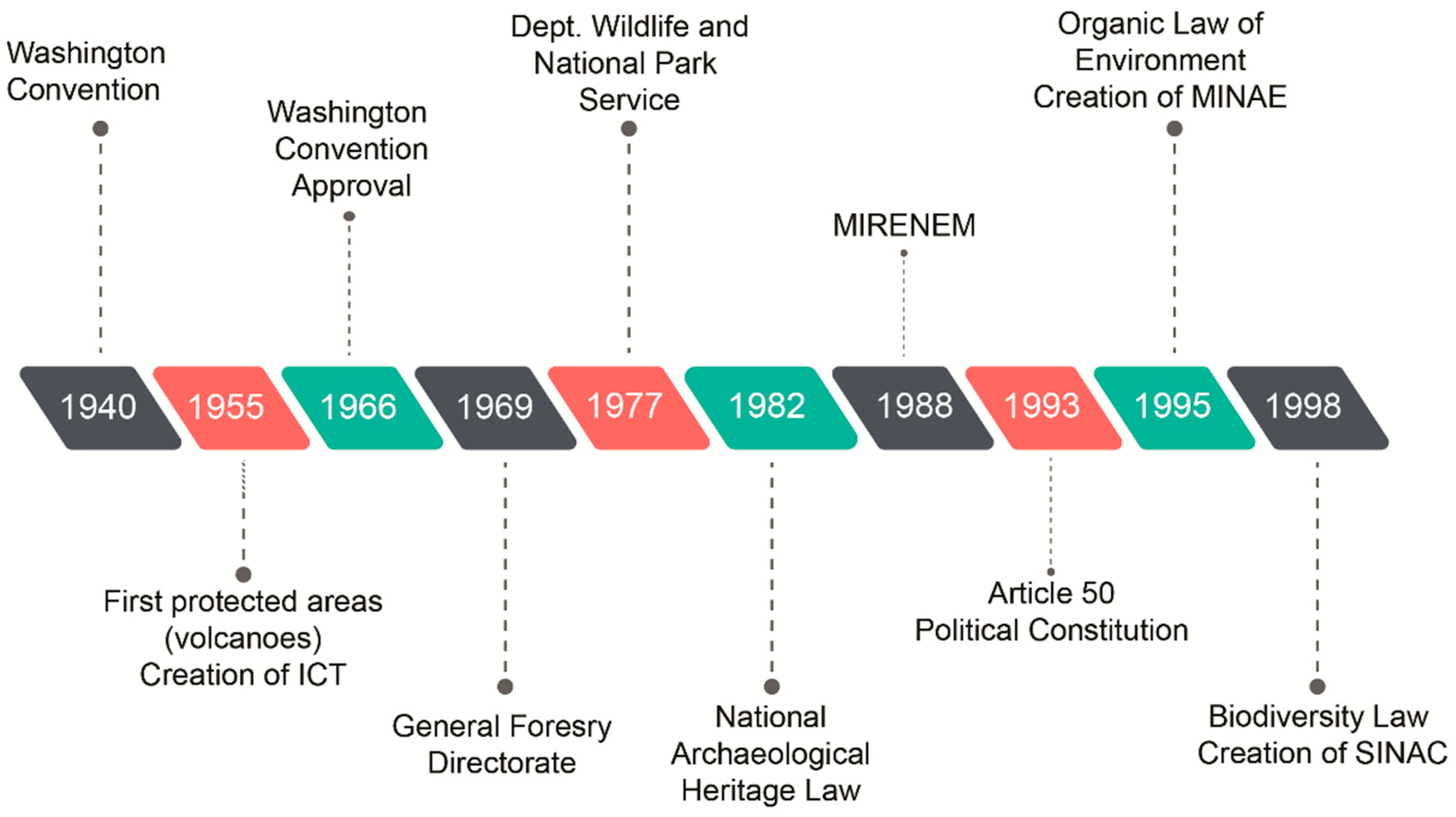
© 2020 by the authors. Licensee MDPI, Basel, Switzerland. This article is an open access article distributed under the terms and conditions of the Creative Commons Attribution (CC BY) license (http://creativecommons.org/licenses/by/4.0/).
Share and Cite
Quesada-Román, A.; Pérez-Umaña, D. State of the Art of Geodiversity, Geoconservation, and Geotourism in Costa Rica. Geosciences 2020, 10, 211. https://doi.org/10.3390/geosciences10060211
Quesada-Román A, Pérez-Umaña D. State of the Art of Geodiversity, Geoconservation, and Geotourism in Costa Rica. Geosciences. 2020; 10(6):211. https://doi.org/10.3390/geosciences10060211
Chicago/Turabian StyleQuesada-Román, Adolfo, and Dennis Pérez-Umaña. 2020. "State of the Art of Geodiversity, Geoconservation, and Geotourism in Costa Rica" Geosciences 10, no. 6: 211. https://doi.org/10.3390/geosciences10060211
APA StyleQuesada-Román, A., & Pérez-Umaña, D. (2020). State of the Art of Geodiversity, Geoconservation, and Geotourism in Costa Rica. Geosciences, 10(6), 211. https://doi.org/10.3390/geosciences10060211





